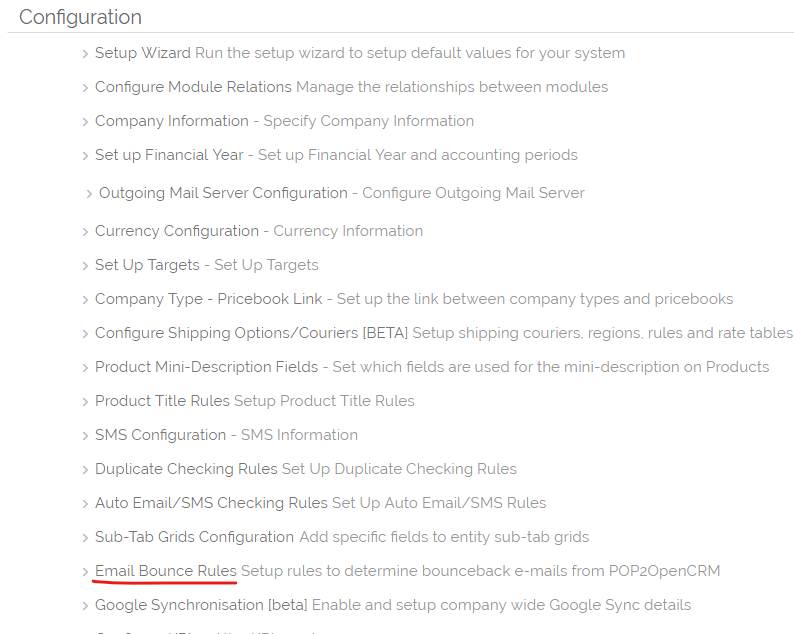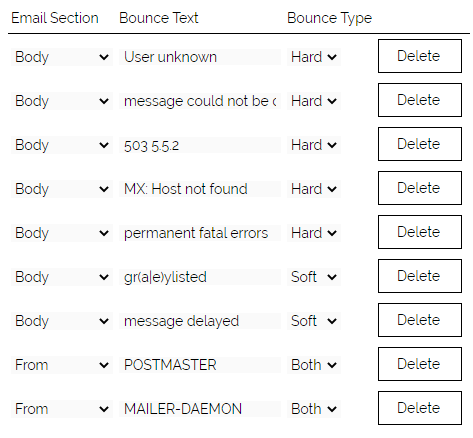OpenCRM will let you track hard and soft bounces against contacts, companies, leads and campaigns if your system is set up with POP2OpenCRM. But before we get into that, let's define what that means.
What are hard and soft bounces?
When sending e-mails, either from OpenCRM or from a mail client, there are times when you may get a bounce back message. These messages fall into two categories, hard bounces and soft bounces.
Soft bounces are messages which have managed to reach the recipient server but have not been delivered to the user at the other side. This could be due to them being over their mail quota, temporary problems with the mail server or any other transient problem. Basically, any issue in delivering the mail which could be considered temporary is a soft bounce.
Hard bounces are messages which have been sent to the server, but the server is rejecting the message without any attempt to deliver it. This could be because the e-mail account doesn't exist, the domain doesn't exist or even the receiving server is blocking e-mails from a specific e-mail address. These are all permanent issues so they, and any other permanent issue are considered a hard bounce.
How can OpenCRM help me track bounces?
When e-mails are sent from OpenCRM to contacts, companies or leads, they are usually sent with some embedded code in them which will allow them to be linked back to these records, if that e-mail is replied to and contains the original e-mail from OpenCRM. If, when this e-mail is sent, it is bounced by the receiving mail server and the bounce contains the original e-mail - as can be the case - POP2OpenCRM can be set to register this as a bounce against the record in a manner which can be reported on, and have a custom view configured to display records which have bounced e-mails.
OpenCRM has a number of rules pre-configured to detect bounces, but you can add your own to your system should you wish to do so. Setting up these rules is done from within the configuration settings block of the settings page. 
This section contains a link to "Email Bounce Rules" which, by default, looks like the image shown to the right. There are three different columns which are required for the rule to be active on the system:

Email Section:
This is the part of the e-mail that will be searched for a specific piece of text which will indicate a bounced e-mail. The available options are "Body", "Subject", "From" and "To/CC/BCC". These correspond to common parts of e-mails where content will be searched. The "From" and "To/CC/BCC" sections will search the e-mail addresses in the relevant section.
Bounce Text:
Bounce text are the word(s) or phrase which will indicate a bounce back message. This can be any length up to 100 characters per entry, and only one of these needs to be met when searching the e-mail for it to be flagged as a bounced message. As a result, the more specific the text is, the less likely it will be that a non-bounced e-mail will be flagged as a bounce.
Any text entered here is case sensitive.
Bounce Type:
This determines whether the rule can apply to a hard bounce, a soft bounce, or both.
In what order are the rules processed?
When the e-mails are checked, the e-mails are checked to see if they are hard bounce e-mails. If this is the case, then they will mark the e-mail as a hard bounce and not process any further rules.
If no hard bounce rule is met, it will check the soft bounce rules to try and find a match. If there is a match, it will flag the e-mail as a soft bounce and not check the rules which can apply to both.
If there are no hard or soft bounces matched, the rules which apply to both will be considered. If a rule which can apply to both is matched, then the e-mail will always be marked as a soft bounce.
How are bounced e-mails recorded?
The bounced e-mails are recorded on contacts, companies and leads in two different ways. Firstly, the record is marked as having e-mails bounced. This is a checkbox which can be edited on the record and unchecked. This will allow you to update the e-mail address on the record, and therefore you would want to reset the box which identifies the record as having an e-mail address which causes bounced e-mails.
The bounce is also recorded in a field on the record which can be seen on the detail view screen. This shows a history of the times an e-mail to the record was bounced, and what the e-mail address was at the time of the bounce.
This is displayed under the "Bounce Information" section:

For a hard bounce, the email address is removed from the contact record entirely and copied to the "Bounced Address" field. The email bounce history will show all previous bounced addresses.
Bounces on Campaigns
Within campaigns, the bounced e-mails are recorded as being either a soft bounce or a hard bounce, and only the count of the relevant bounces are recorded. This information is available in the detail view of the campaign within the Results section. This information comes from the Contact, Lead, or Company record. If the record is linked to the Campaign and the status of that Campaign is not closed, bounces will be listed.
Statistics, including bounces, are not updated on Campaigns that are of a closed status.
You can change which of your Campaign Statuses count as being "closed" by going to Settings > Configuration > Additional Settings and clicking the Campaign option at the top. From there, you simply add the statuses, one per line.
Remember: any Campaign with status in this list will not have statistics recorded against it.
 Retain email address on hard bounce
Retain email address on hard bounce
It is possible to configure OpenCRM to retain (not remove) the email address on the record when a bounce is recorded. This is done by the additional setting under Pop2OpenCRM Settings:
"Remove email address from the record when a hard bounce is detected"
This is ON by default but can be turned OFF to retain the email address on the record when a bounce is detected.
Need More Help?
If you have any questions, just start a Live Chat, "Click" on the Chat Icon in the lower right corner to talk with our support team.


